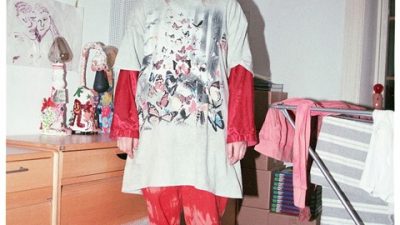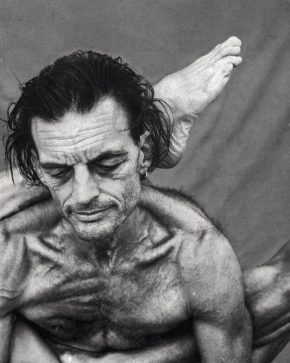Tenkara Fishing and Traditional Fishing Flie

The right and left side tail feathers of a peacock, which is used as a material to make fishing flies (produced in Ishigakijima, Okinawa Prefecture).
“Fly fishing”, which consists of using flies disguised as insects to catch trout, who feed on aquatic insects such as mayflies that fly around the surface of rivers, has a long and extensive history. The details of its origins are not certain, but it is said that the act of catching fish using flies existed in Macedonia and was described by Roman author Claudius Aelianus in his book on natural history.
It was also widely popular among the noble class in England during the 17th century, and the technique was also described in Izaak Walton’s “The Compleat Angler” (1653) and John Dennys’ “The Secrets of Angling” (1652), two works that are known to be literary masterpieces regarding the art of fishing.

The mayfly, an aquatic insect that is an important food source for trout.
Towards the end of the 19th century, the tools and techniques continued to evolve. The fishing rods, which had been made from wood, became smooth bamboo, while the fishing flies, which had been made from horsetail hair, shifted to silk. Fly fishing made its way to the United States years later, where it continued to develop independently from its origins. In addition to the spread of new technology, such as the use of carbon rods and nylon lines, the United States became the place with the most advanced fly fishing techniques beginning in the mid-20th century up until today.
In contrast to fly fishing, of which its roots are in Western Europe, a fishing technique using traditionally Japanese-style fishing flies has also existed in Japan for many years. During the Edo period, while fly fishing was widely practiced to catch sweetfish in the rivers near villages, a different style of fishing using flies to catch fish such as Arctic char and trout was practiced in mountain streams. Today, the latter style is referred to as “Tenkara fishing”.


Many theories existed about the birthplace and origins of “Tenkara fishing” and there are many mysteries surrounding it, but the use of that name to describe all Japanese-style fly fishing taking place in mountain streams began as recently as the mid-1960s. In any case, what is important is that while fly fishing was widely enjoyed in England more as a hobby, Tenkara fishing was passed down in Japan by professional fishermen and hunters who sold the fish that they caught to mountain lodges.
Although not much information about the history and tools used for Tenkara fishing has been preserved, many of the techniques developed by professional fishermen who dwelled in the mountains have been passed down to future generations.

Tenkara fishing, which does not use fishing reels, was developed in mountain streams in Japan, where the rivers are relatively narrow.
In contrast to fly fishing where fishing rods are equipped with reels, a simple rod and string are used for the Tenkara tackles. Originally, the rods were made with bamboo, the lines were made with horsetail hair, and the fishing flies were made from the feathers of various birds such as copper pheasants and peacocks, or from the cotton extracted from flowering ferns.
These fishing flies were constantly being developed and evolved as “trade secrets” through trial and error by fly craftsmen all over Japan, and were only passed down to a select handful of people. Today, these rare fishing flies are referred to as “traditional fishing flies”.

A reproduction of the legendary Oku-Nikko Gorochi fly, made using the brightly colored feathers of female pheasants.

A fishing fly that uses the thread made from the cocoon of a Japanese silk moth./A fishing fly made from the covert feathers of a peacock.

A “sakasa kebari” or “backwards fly” is unique to Tenkara fishing. The fly opens up when it is pulled through the water upward and downward.
Mr. Takaaki Sasaki, owner of online shop “Sasaki Densyo Kebari” in Koga, Ibaraki Prefecture, is a rare “fishing fly expert” who collects information about traditional fishing flies from various regions and manufactures and also making them available through his shop. Born and raised near Watarase River, a major river in the northern Kanto region of Japan, Sasaki fell in love with fishing at a young age.
“When I was a child my uncle gave me old fishing flies, and I was mesmerized by their different colors. I always thought that I wanted to try catching fish with them one day,” he says. As fly fishing requires highly specialized knowledge, experience, and technique, “I was taught by older fishermen about the art of fly fishing, and began investigating and learning more about old fishing flies on my own”.

“Masutsuri Fu Iwana Yamame”, published in 1935 (Author: Kouki Meguro, Tokyo Sugiyama Shoten). Information regarding traditional fishing flies is collected from past literary documents such as this one.

As mentioned earlier, information regarding traditional fishing flies was kept strictly confidential and was not disclosed to the general public, so learning about traditional fishing flies that only experienced fishermen were familiar with, who were well-versed on the ecology of fish in their nearby habitats is not an easy thing to do.
“I studied up on traditional fishing flies by reading the few documents that have been preserved over time and talking with local fishermen. Traditional fishing flies have been passed down with care through generations but it still remains highly secretive, so it was difficult to even get people to show them to me. I was able to earn their trust over time and finally was able to get them to teach me about the materials used to make and assemble traditional fishing flies.”

Feathers from a kingfisher, considered the gem of mountain streams.

Feathers from a crested kingfisher, considered the best hunters in mountain streams.
Most of the information was passed down through word of mouth, so the original shape of fishing flies remains unclear, and not many actual traditional fishing flies remain today.
“For example, the “Gorochi fly”, which was commonly used by fishermen at Lake Chuzenji in Nikko, was made from the feathers of female Japanese pheasants and tied together using thread made from the cotton extracted from flowering ferns.
There is only one known Gorochi fly that exists today and is exhibited at a museum, but no one knows whether it is the real thing or when and who it was made by. The only way to determine its authenticity is to match it with the details described in old documents. There are also fishing flies called “Kingoma” and “Gingoma”, which were made from the feathers of Japanese bantams and also used in the Nikko region; these two types were previously discovered at an antique flea market.”

Cotton extracted from flowering ferns, which is primarily used as a material to make fishing flies.

Feathers from the back of a peacock (produced in Ishigakijima, Okinawa Prefecture).
Many of the traditional fishing flies were made with materials distinct to the regions where they came from, and there are countless different types of fishing flies with unique characteristics throughout Japan.
“The “Togatta fly” that was used by fishermen in the Sumikawa region in Miyagi Prefecture, is an extremely unique type. A fisherman friend of mine who I had known for many years taught me that instead of using tail feathers of copper pheasants, the Togatta flies were made using the bone marrow of the pheasants that appeared when the feathers were plucked. At Watarase River in Tochigi Prefecture, best known for being the home of the Ashio Copper Mine, the fishing flies are tied with copper wire instead of the standard thread to make them heavier.”

Tail feathers from a copper pheasant used to make the “Togatta fly”./The covert feathers of a peacock (produced in Ishigakijima, Okinawa Prefecture).
By utilizing the knowledge and experience gained over the years, Sasaki spends his days manufacturing fishing flies inspired by the traditional. Stabilizing a hook with a fly tying vise, he carefully ties together rare materials using silk thread and creates beautifully handcrafted fishing flies.
“I put my own twist on the traditional fishing flies and sell them as originals. In recent years, many cheap knockoffs have been circulating over the internet, so I pay careful attention to prevent imitation fishing flies from being sold.”

Mr. Sasaki using tools such as a vise, bobbin holder, and whip finisher to tie a traditional fishing fly.

Utilizing local plants and animals, many of the traditional fishing flies that were refined over the years was a tool of necessity used by professional fishermen to catch as many fish as possible in short periods of time avoiding damage to them from overuse. On the other hand, although they were manufactured strictly as fishing tools, Sasaki was mesmerized by their physical appearance as well as the subtle details incorporated into making them.
“To be honest, if you use an authentic fishing fly and have the proper technique, you can catch fish using any type of fly. However, real fishermen never compromised their appreciation for the aesthetic beauty and functionality of their valuable tools. The fishing flies were never meant to be made to show off to others. In the past, craftsmen were extremely particular about the fishing flies they used when crafting them. I always thought this philosophy and way to be cool and pure.”

A fishing rod from American brand “TENKARA ROD Co.”. With a total length of 8 feet (2.40m), the rod features a short design.
Fishing using Japanese-style flies was relatively common in various regions until around the 1950s, but the deterioration of the natural environments during the period of high economic growth resulted in a decrease in the number of fish in the rivers, and fish such as char and trout were primarily farm-raised. The changes of the times ultimately led to a temporary disappearance of the Tenkara fishing technique. However, in recent years Tenkara fishing is showing signs of a revival. “Today, Tenkara fishing is beginning to become more and more popular in the United States, the home of fly fishing,” says Daisuke Tsuchiya owner of “GROUNDSTORE”, a specialty shop in Chofu, Tokyo that carries Tenkara fishing-themed fashion products and outdoor gear.
Rod maker “TENKARA USA”, which is also carried by the store, is a brand that was founded in Boulder, Colorado in 2009. “The idea of Tenkara fishing, which uses lightweight and simple systems to catch fish, has become very popular among backpackers and minimalists who are very particular about the tools they use.”
Tenkara fishing is the ultimate rational technique that has been polished and developed by professional fishermen. Its functional beauty is now making a comeback on the world stage.

A look inside “GROUNDSTORE” a specialty shop located in Chofu, Tokyo.


SASAKI DENSHO KEBARI
6-2 NISHIKI-CHOU, FURUKAWA-CITY, IBARAKI 306-0037
Closed: No scheduled
densyo-kebari.com
GROUNDSTORE
1-23-11 WASHINOUE BLDG 1F, KOKURYO-CHOU, CHOFU-CITY, TOKYO 182-0022
042 480 0595
Opening Hours: 15:00-21:00
Closed: Every Sunday and Holiday
groundstore.jp

























Comments